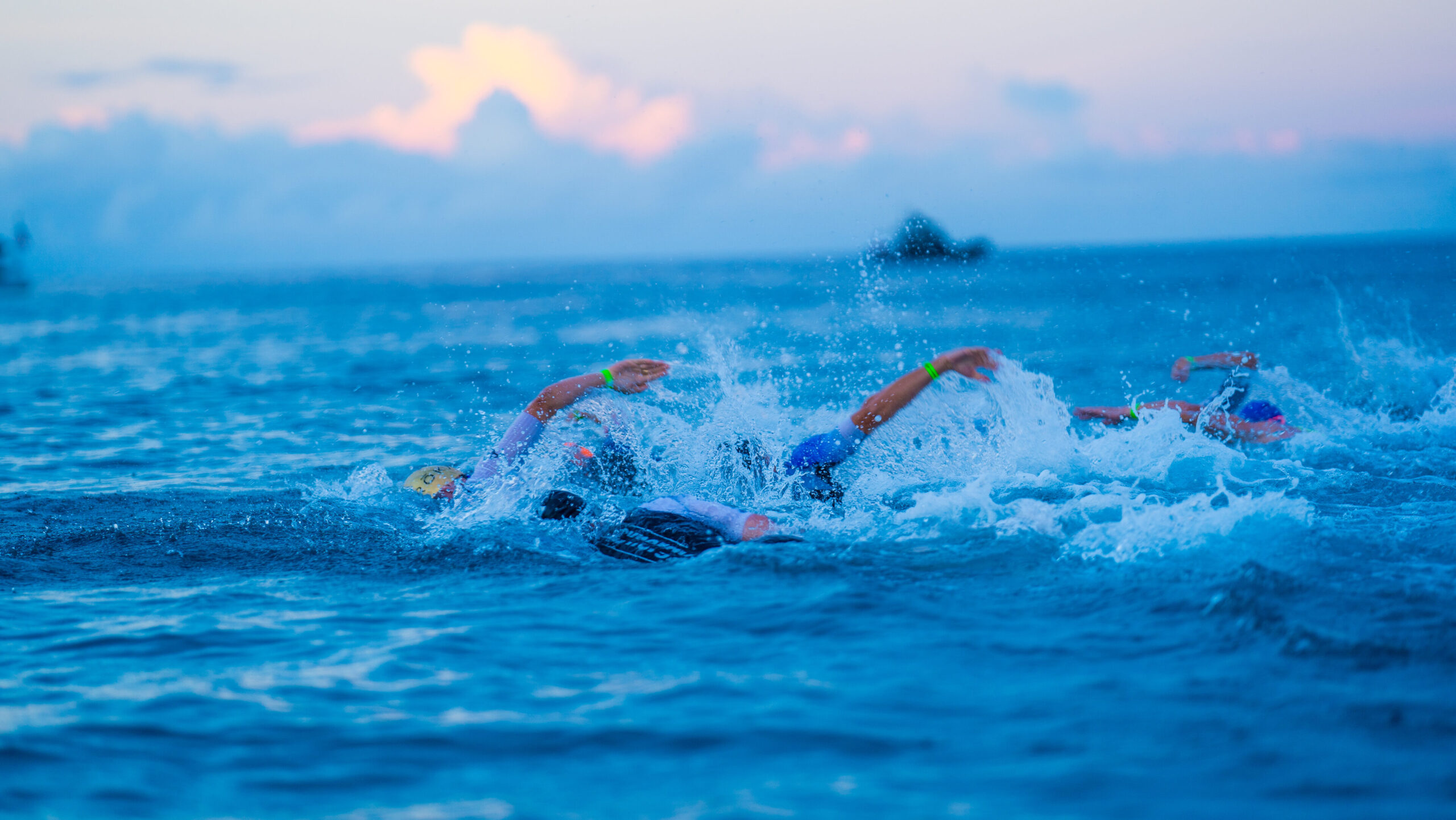The Dos and Don’ts of the Ho’ala Training Swim

Photo: Kevin Mackinnon
I have never been to Kona, so I was understandably eager to get down to Kailua Bay for a swim to experience the crystal-clear water for myself. I was even more excited to get the chance to compete in the Ho’ala Training Swim alongside almost 800 other athletes. I don’t see myself qualifying for Kona any time soon, but getting the opportunity to race here in any fashion was quite exciting.
Unfortunately, the swim wasn’t in my plans too far in advance of my trip to the Big Island, so I showed up at Kamakahonu Beach rather under-prepared. (As opposed to Lucy Charles-Barclay, who won the women’s pro category in 36:30, well ahead of fellow Brits Stephanie Clutterbuck, 37:26, and Fenella Langridge, 37:28. Brazil’s Matheus Evengelista won the men’s race in 34:04.)
Fortunately, my lack of preparation gave me a great learning experience that I am happy to share with anyone else who will be looking to do the training swim (or any open water swim) in future years. So, without further ado, here are the dos and don’ts of the Ho’ala Training Swim.
Do Bring Spare Goggles
If you’re like me, finding a good pair of goggles that fit your face well and don’t leak is a struggle. So, when you do find that perfect pair, you hold onto them for as long as you can. I’ve had the same goggles for a few years now for that very reason — they’re perfect for me — and it never crossed my mind to bring a spare set to the beach.
Well, Murphy’s Law, poor planning and simply bad luck led to me snapping them as I put them on just minutes before the pro women jumped into the water. In a stress-filled 10 minutes, I hurried around the beach asking volunteers if they knew of anywhere I could find another pair.
One volunteer led me to another, then another, and so on, until finally someone said they knew where to go. She took me to the swim start, where she pointed to a big box labelled Spare Goggles. I found a pair that fit my face (and miraculously didn’t leak for the entire swim), and was able to get in the water in time.
Do Open Your Eyes
Since you’ll avoid my mistake and bring a spare set of goggles, you’ll want to put them to good use when you get into the water. I was so focused on setting a good pace, catching people and drafting off of others that it took me half the swim to realize that I should take in my surroundings.
I was in Nice a few weeks ago for the men’s IRONMAN World Championship and, while it’s wonderful swimming in the Mediterranean, all you can see is blue. It’s still beautiful, but it’s drastically different than the water in Kona, where you can see everything. There are so many fish swimming just beneath you as you power along the water’s surface — it’s as if a snorkelling trip met an endurance race. So, if you’re lucky enough to do the Ho’ala swim (or to swim in Kailua Bay at all), be sure to open your eyes and enjoy the views.
Don’t Wing It
As triathletes, we like a challenge. That’s why we’re into this sport. Sometimes, however, we should take a step back and think about the challenges we’re planning to tackle. Signing up for an IRONMAN in eight months? That’s a good challenge. Hard, but achievable. Entering a 2.4-mile ocean swim without having been in the pool all that much in the last three months? Maybe not the wisest of choices.
The thing is, though, that sometimes the obviously unwise choices seem more fun to us because, “If I can pull that off, it’ll be even cooler.”
I knew I could swim 2.4 miles, but I wanted to swim it quickly. The trouble with trying to swim such a long distance with very little training is that you won’t have much of an idea of how to pace it. You might go out too slowly and kick yourself at the end for not going harder. You might go out too hard and hate yourself for the back half of the race as you struggle toward the finish. You probably won’t fluke your way into a perfectly paced race.
I was standing in line at the swim start trying to figure out my pacing strategy (another bad call — maybe try giving yourself more than a few minutes to plan your race) when I heard an announcement stating that the race had been shortened from 2.4 miles to 1.6. This was a shame for everyone else racing and, while I was let down, too, I recognized that I’d been given a mulligan on this one. I probably didn’t pace the 1.6 miles all that well, but in the end, I made it to the line without being completely dead (which almost certainly would have been the case if I’d had to swim the extra 0.8 miles).
Don’t wing it when it comes to the Ho’ala Training Swim. Even a little but of planning and foresight will go a long way.
Do Use Anti-Chafing Cream
As I mentioned above, I swam in the Mediterranean a few weeks ago. At no point in my trips to the sea did I chafe. I saw other athletes putting anti-chafing balms and creams on their armpits before getting into the water, but I didn’t have any and it turned out I didn’t need it. After facing no issues in Nice, chafing wasn’t even a thought as I packed for Kona. It should have been.
I don’t care if you’ve never chafed while swimming. You are going to hate yourself during and after the swim if you don’t proactively apply some sort of anti-chafing agent. Do yourself a favour and get a tube of it before swimming in the ocean. (You’re welcome in advance.)
Don’t Stay Silent
For a few moments when my goggles snapped, I considered “MacGyvering” my way into a solution. I really didn’t want to bug anyone. I realized that I had almost 800 athletes around me, many of whom might have had spare goggles, but I didn’t want to be that guy. I also didn’t want to bug the volunteers. They were in charge of checking athletes in, taking their bags, getting us in line for the start. I didn’t want to ask someone to help me with something that wasn’t their specific duty. Maybe I’m too Canadian. I don’t know.
Ultimately, I did ask for help. The first volunteer I spoke with had no clue where to find goggles, but she took me to someone else. Same with that volunteer — no idea where spare goggles might be — but he was happy to help me search for them. Soon enough, we found that Spare Goggles box and I was able to go ahead with the swim.
It was a good reminder that these volunteers want to be there. They want to help the athletes, and if they don’t have an answer to a question, they are eager to find it. So, don’t be like me, don’t assume you’re going to be a nuisance — if you have a problem at an event, ask for help and someone will be sure to help you find it.




Why was the course significantly shorter than normal?
Lack of volunteers.
so its the IM WC , the pinnacle of our sport and one of the major events in race week which they charge a good $$ for and they cant organise enough swim safety
its not as if they didnt have time to get it organized etc
WTF
and best tip is dont do the Hoala swim and do what we did and swam 4k at the majical hepuna beach (we swim there all race week to avoid the tripical triathlon behavior that goes on in town )
water is sooo much clearer , cost nothing if u park outside the gate and u will see manta rays and all sorts as well as the usual tropical fish
plus u can ride straight out onto the queen k and up to hawi if thats the way u roll
Great tip on “Don’t stay Silent” - I can add my experience after my goggles broke 1500m into the Kona swim last year. I tried swimming on without goggles for a couple of minutes before I asked a marshall on a jetski if anyone had some spare goggles - I had seen the spare goggles box at the start. A few minutes later he reappeared holding a pair of zoggs. Amazingly they fitted perfectly and didn’t fog - it completely saved my eyes, my swim and my day.
Locals not interested in supporting the race this year?
The increased current on the day required more volunteers than normal. So it’s not as bad as everyone is making it out to be.
Thanks for clarifying that.